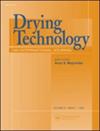木薯制品的通用干燥模型
IF 2.7
3区 工程技术
Q3 ENGINEERING, CHEMICAL
引用次数: 0
摘要
干燥是许多食品加工的关键步骤,例如木薯粉的生产。没有特定的计算机辅助工程(CAE)工具可用于协助木薯干燥设备的设计。在本研究中,在文献中选择了对流扩散模型,因为它的通用性和适合于工程目的。三个干燥动力学足以确定所需的温度依赖的有效扩散率。他们在40-80°C的空气中进行测量,空气垂直于木薯圆柱体流动。为了验证,在40-80°C的气流中干燥、平行或垂直于产品层的四种不同来源、转化水平、几何形状的木薯产品上,共测量了36种动力学。利用文献中的3个特性和一些简单的实验室测量,该模型能够准确地预测(RMSE: 0.04 d.b.)木薯制品从面粉到根切的所有干燥动力学。作者感谢Jean-Michel msamuot博士的建议和专业知识。作者还感谢Jean-Paul Fleuriot的技术支持。他们也感谢Noël akissosoise博士的研究小组在bsamin农艺科学学院(FSA)。亚历山大Bouniol;以及来自ksamuou和bsamuin的木薯加工者,来帮助他们获得发酵的根。作者还感谢Dominique Dufour博士作为RTB项目协调员为这项工作提供了便利。这篇文章经过了细微的修改。这些变化不影响文章的学术内容。披露声明作者报告无利益冲突。作者独自负责论文的内容和写作。注1风机电机功率为4kw,由20 ~ 50hz变频器控制。蒸汽发生器容量为10 kg·h−1,0 ~ 100%可调。电阻功率为12 kW,由调光开关控制,调制为0 - 100%。2 https://imagej.net/Additional信息资助为本研究进行的研究是CGIAR根、块茎和香蕉研究计划(RTB)的一部分,并由CGIAR信托基金捐助者(https://www.cgiar.org/funders/)和法国蒙彼利埃的法国国际发展农业研究中心(CIRAD)提供支持。本文章由计算机程序翻译,如有差异,请以英文原文为准。
A generic drying model for cassava products
AbstractDrying is a a critical step in many food processes, e.g. in the production of cassava flour. No specific Computer Aided Engineering (CAE) tool is available to assist in the design of cassava drying equipment. In this study, a convective-diffusive model was selected in the literature for its genericity and suitability for engineering purposes. Three drying kinetics were sufficient to identify the required temperature-dependent effective diffusivity. They were measured under 40–80°C air, flowing perpendicular to the cassava cylinders. For validation, a total of 36 kinetics were measured on four cassava products of different origins, levels of transformation, geometries, dried in air flows at 40–80°C, parallel or perpendicular to the product layer. Using 3 properties taken from the literature and few straightforward lab measurements, the model was able to accurately predict (RMSE: 0.04 d.b.) all drying kinetics for cassava products from flour to root cuts.Keywords: Dryingsimulationdiffusivitycassava AcknowledgmentsThe authors thank Dr. Jean-Michel Méot for his advice and his expertise. The author also thank Jean-Paul Fleuriot for his technical support. They also extend their thanks to Pr. Noël Akissoé’s research team at the Faculty of Agronomic Sciences (FSA), Bénin; Alexandre Bouniol; and the cassava processors from Kétou, Bénin, to help them to acquire the fermented roots. The authors also gratefully acknowledge Dr. Dominique Dufour for facilitating this work as RTB project coordinator.Correction StatementThis article has been corrected with minor changes. These changes do not impact the academic content of the article.Disclosure statementThe authors report no conflicts of interest. The authors alone are responsible for the content and writing of the paper.Notes1 The fan motor had a power of 4 kW and was controlled by a 20−50 Hz frequency inverter. The steam generator had a capacity of 10 kg·h−1, 0 to 100 % adjustable. The electrical resistances had a power of 12 kW, and were controlled by a dimmer switch with 0−100 % modulation.2 https://imagej.net/Additional informationFundingThe research conducted in preparation for this study was undertaken as part of, and funded by, the CGIAR Research Program on Roots, Tubers and Bananas (RTB) and supported by CGIAR Trust Fund contributors (https://www.cgiar.org/funders/) and French Agricultural Research Center for International Development (CIRAD), Montpellier, France.
求助全文
通过发布文献求助,成功后即可免费获取论文全文。
去求助
来源期刊

Drying Technology
工程技术-工程:化工
CiteScore
7.40
自引率
15.20%
发文量
133
审稿时长
2 months
期刊介绍:
Drying Technology explores the science and technology, and the engineering aspects of drying, dewatering, and related topics.
Articles in this multi-disciplinary journal cover the following themes:
-Fundamental and applied aspects of dryers in diverse industrial sectors-
Mathematical modeling of drying and dryers-
Computer modeling of transport processes in multi-phase systems-
Material science aspects of drying-
Transport phenomena in porous media-
Design, scale-up, control and off-design analysis of dryers-
Energy, environmental, safety and techno-economic aspects-
Quality parameters in drying operations-
Pre- and post-drying operations-
Novel drying technologies.
This peer-reviewed journal provides an archival reference for scientists, engineers, and technologists in all industrial sectors and academia concerned with any aspect of thermal or nonthermal dehydration and allied operations.
 求助内容:
求助内容: 应助结果提醒方式:
应助结果提醒方式:


